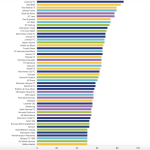
Which were the most sustainable football clubs in the last season?
There are two Italian teams in the top ten
June 20th, 2023
It is not only the results on the pitch and the players that help create a sense of belonging between clubs and fans. The latter increasingly demand from clubs a commitment to social and environmental struggles, with which they identify and which allow them to feel part of a large community. Clubs, also thanks to a change in mentality driven in particular by Gen Z, must increasingly be able to interact with all fan communities, heterogeneous and actively involved in issues such as the protection of minorities or the fight against climate change.
Also in 2023, clubs have been active in minimizing environmental impact, carbon emissions, water saving and making their facilities energy self-sufficient. With the season now over, consultancy firm Brand Finance has compiled the 2023 Football Sustainability Index, a report highlighting the most sustainable clubs of the season among the five European leagues. The survey was done among fans, taking different metrics divided into three sections: environment, social, governance.

How the projects are communicated externally, the club's involvement with social realities and its commitment to environmental protection all play a role in the report. On a scale from 0 to 100, Liverpool FC comes first in the ranking, with a score of 86, which stems from the English club's ability to communicate ESG campaigns; in the past year alone, Liverpool has been involved in two thousand charitable projects.
On the second step of the podium is Betis Sevilla (83), whose 'Forever Green' climate change awareness platform is using football as a model to drive change, a project also carried out with the installation of 25 wind turbines in Costa Rica. The third step of the podium is occupied by Real Madrid, a model club on the pitch and also for its commitment to reducing water waste in all training facilities. The fields of Real Madrid's 'Ciudad' are irrigated thanks to rainwater collection systems recycled from Madrid's municipal networks. Completing the Top 10 are Udinese (78.8); Stade de Reims (77.3); Racing Club de Lens (77); Real Sociedad (73.5); AC Milan (73.3); Freiburg (72.4) and Nottingham Forest (70). There are also two other Italian teams in the top 20, Juventus and Inter Milan, in fourteenth and eighteenth place respectively.

This ranking does not refer to absolute sustainability, there are still many goals to be achieved, such as in the area of merchandising production or economic sustainability, a topical subject especially in the football market period. The virtuous examples are there, and they start from individual aspects, Udinese took fourth place in the ranking thanks to its adhesion to the United Nations' 'Sports for climate action' program, and after making the Dacia Arena one of the first carbon-neutral and renewable energy powered stadiums in Europe.
Perhaps it is no coincidence that two of the most successful clubs of recent years are among those that have adopted the best strategies in terms of sustainability. In addition to Foundazione Milan, Liverpool's Red Way is a pioneering strategy and fits with the goals set by the 2030 Agenda for Sustainable Development, the 2015 document in which the UN set 169 targets, summarised in 17 thematic goals, to be achieved by 2030.












